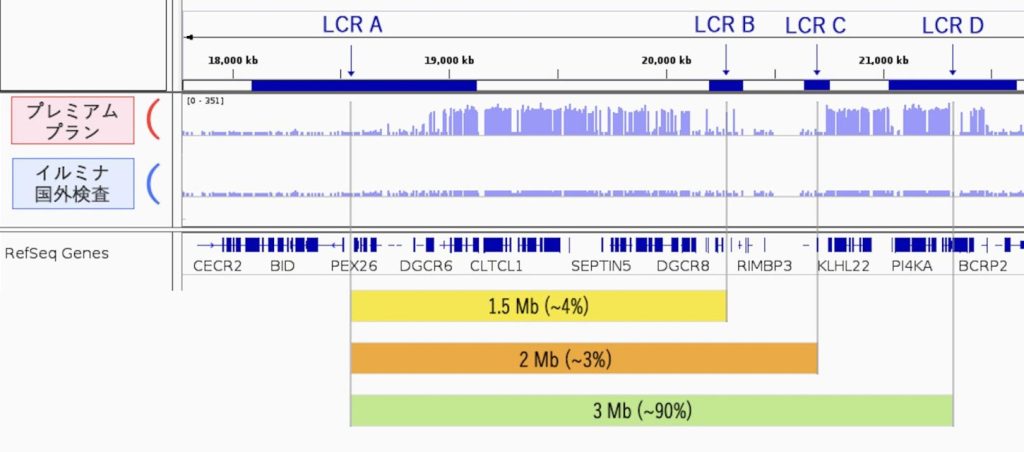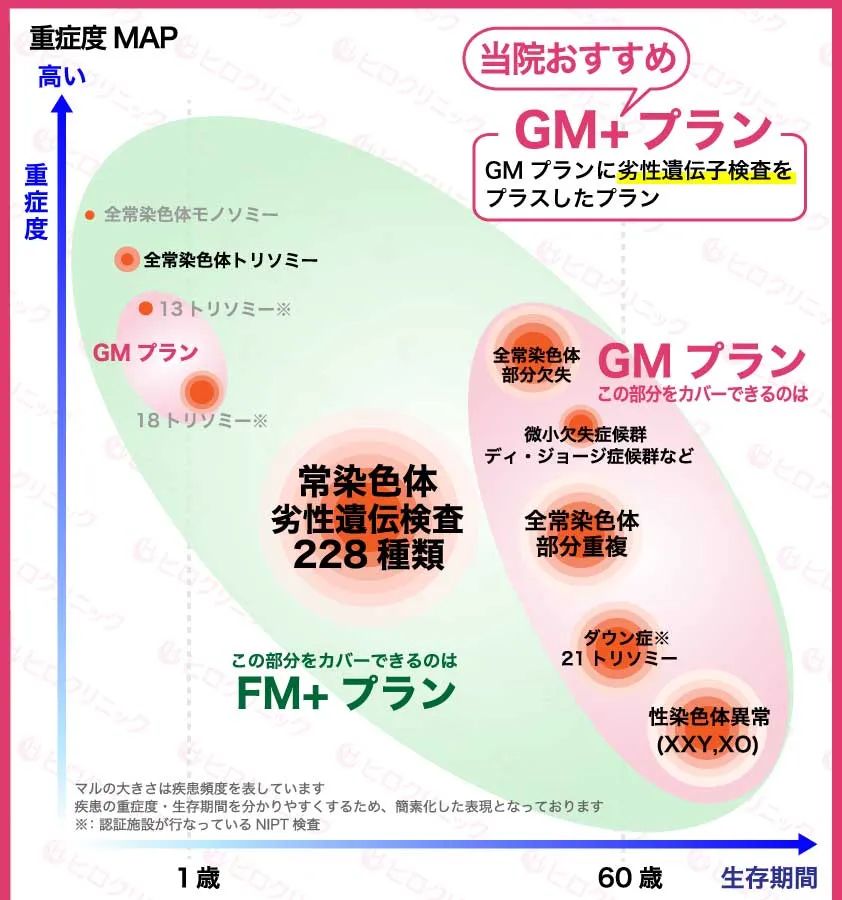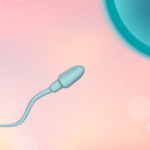More than half of the people are currently choosing the Premium plan.

Hiro Clinic offers both Premium and Non-Premium plans. The difference lies in whether the highly accurate Medicover method is used. There are various methods for NIPT, and their accuracy differs. In particular, the recently developed techniques for detecting small deletions, such as microdeletion syndromes (designated intractable diseases), require the Medicover technology. At Hiro Clinic, we validate test results in collaboration with the Tokyo Health Inspection Institute.
| Premium | Non-Premium | |
| Testing Method | Medicover method | Illumina method |
| Testing Depth | 100x | 0.3x |
| Testing Accuracy | Up to 0.5Mb | 7Mb |
| SNP Detection (over 150,000) | Possible | Impossible |
| FF Accuracy | Excellent (using SNP) | Average |
The most significant difference between the two plans is the reading depth during sequencing. For example, let’s look at the reading depth related to DiGeorge syndrome. The top shows the Premium plan, and the bottom shows the Basic plan. The vertical axis in blue indicates that a higher value corresponds to a deeper reading depth. The Illumina method reads at basically the same depth across all locations, which is why it doesn’t achieve greater depth. Since the reagent amounts are the same, reading broadly results in shallower depth.

Therefore, while the Basic plan can detect partial deletions and duplications up to 7Mb in size without issues, it becomes difficult for anything smaller. The 7Mb figure might not be very clear, so I’ll provide a bar graph for reference. The size of chromosome 21 is 46Mb. Even with an Illumina method testing depth of 0.3x, detecting chromosomes 21, 18, and 13 is still feasible.

However, with this technology as it stands, it cannot capture microdeletions. For the smallest and most common DiGeorge syndrome (designated intractable disease 203), over 90% of deletions are less than 3Mb. This cannot be detected using the Illumina method. The microdeletion syndrome tests being conducted overseas (using the Illumina method) employ this alternative technique.
As explained on another page, in the Illumina overseas tests, results that are positive with an FF (Fetal fraction) of less than 10% will turn negative.

About half of the cases have an FF of 10% or lower.
Additionally, in the Basic type, there is a possibility that the FF may not be accurately reported. If this is not detected correctly, the results can be inconsistent. Illumina estimates the FF statistically based on the differences in the lengths of fetal cfDNA, while the Medicover method measures it using SNPs. SNPs provide unique genetic information for each individual, allowing accurate detection of the FF by analyzing the fetal DNA inherited from the father. However, to read accurately, a minimum depth of at least 30x is required. Therefore, the Medicover method narrows the reading range to achieve deeper readings. I will present a graph showing the FF measured by both methods at the Tokyo Health Inspection Institute. This demonstrates how much the Illumina and Medicover methods differ for the same patient.

If both methods were the same, the points would align closely along the red line, but there is noticeable variability. The correlation coefficient rrr indicates how closely they match, with values near 1 signifying similarity. In this case, the coefficient is 0.83, indicating that the accuracy is not perfect.
Accurately reading the FF means distinguishing between the fetus’s and the mother’s genes. This technology significantly improves the accuracy for multiple pregnancies. Even when an ultrasound shows only one fetus, there can be cases of vanishing twin syndrome (where one of the originally two fetuses disappears). NIPT can sometimes diagnose vanishing twins based on genetic information. During an ultrasound, the second twin might be too small to detect, but this can also affect genetic testing. However, even in such cases, the Premium plan can still detect it.
So, is Medicover perfect? Not necessarily; while it provides deep readings, its range is limited.
Combining both methods can eliminate many blind spots. That’s why we developed the FM and GM plans within the Premium plan. This combination allows for accurate testing over a broader range. In the diagram below, the red area represents the GM plan, while the green area represents the FM plan. I won’t go into detail about the autosomal recessive gene testing (+) this time, but that is also one of the Medicover tests.

FM covers almost all areas, while the GM plan focuses on cases with longer survival periods. By utilizing both plans within the Premium option, it becomes possible to conduct nearly all tests that can be detected through NIPT.
 中文
中文






